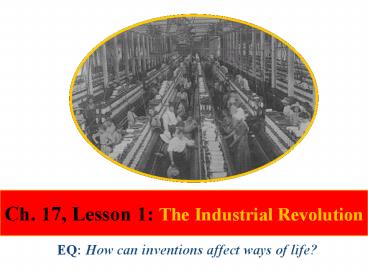Ch. 17, Lesson 1: The Industrial Revolution - PowerPoint PPT Presentation
1 / 20
Title:
Ch. 17, Lesson 1: The Industrial Revolution
Description:
Ch. 17, Lesson 1: The Industrial Revolution EQ: How can inventions affect ways of life? – PowerPoint PPT presentation
Number of Views:107
Avg rating:3.0/5.0
Title: Ch. 17, Lesson 1: The Industrial Revolution
1
Ch. 17, Lesson 1 The Industrial Revolution
EQ How can inventions affect ways of life?
2
Ch. 17, Lesson 1 Vocabulary (pg. 316)
- Industrial Revolution (pg. 316, into.)
- Labor
- Capital
- Entrepreneurs
- Cottage industry
- Urbanization (pg. 320)
3
The Industrial Revolution
- Industrial Revolution is a change from an
economy based on farming and handcrafts, to an
economy based on manufacturing by using machines
in factories. - Began in Great Britain in 1780s, then spread
throughout European and northern United States.
4
Why did it start in Britain?
- Britain had an Agricultural Revolution led to
increased food supply - Increase food supply led to population grow
- Britain had capital (money available for
investment) and entrepreneurs - Britain had natural resourcesrivers, minerals,
etc. - Britain had a market to sell its goods, colonies
overseas
5
The Revolution Began with Cotton
- Britain was leader in cotton production
- Spinners made cotton thread from raw materials
- Weavers wove cotton thread into cloth using looms
- People did this in their homes (cottages), thus
the process is called cottage industry. - Technological advances made cottage industry
inefficient.
https//www.youtube.com/watch?vd4joqYycnqM 4 35
6
Activity
- As you read Cotton Production and New Factories
(pg. 317)identify the three inventions and
inventors that changed the cotton production
industry in England. - Then, explain how their invention changed the
cotton production industry in England.
7
James Hargreaves The Spinning Jenny
- Hargreavess machine allowed spinners to
produced thread faster
8
James Watts Steam Engine
- James Watt enabled the steam engine to drive
machineries - Steam engines now used to spin and weave cotton
https//www.youtube.com/watch?vd4joqYycnqM 650
9
The Coming of the Railroad Trevithicks Engine
- In 1801, Richard Trevithick first attached a
steam engine to a wagon. - Trevithicks engine was not successful for moving
people, but he had planted the idea of human
train transport.
10
George Stephensons Rocket
- Just a few years later, George Stephenson
designed and built the Rocket, the first steam
locomotive practical for pulling rolling stock
(train cars).
11
(No Transcript)
12
Social Impact of Industrialization
- Industrial Revolution changed society
- Between 1800-1850 cites grew
- Also two new social classes emerged
- Industrial middle class
- Industrial working class
13
Population Growth and Cities
- Population Growth in Europe
- 1750 140 million people
- 1850 266 million people
- Industrialization also led to urbanizationpeople
left the country and move to the cities to work
in factories - Cities also grew throughout Europeled to pitiful
living conditions, poverty, and diseases.
https//www.youtube.com/watch?vd4joqYycnqM 830
14
Activity 1 New Social Classes
- Read New Social Classes pg. 320.
- Contrast the Two Social Classes that emerged
during the Industrial Revolution. - Activity directions
- 1. Define the social classes.
- 2. Write 2 characteristics about each class.
Industrial Middle Class Industrial Working Class
Define Define
Characteristic 1 Characteristic 1
Characteristic 2 Characteristic 2
15
Labor Conditions
- Factories were crowded, dark, and dirty
- Workers toiled from dawn to dusk
- Working conditions were dangerous
16
Women Labor
- Factory owners hired women and children because
they worked for lower wages - Women gained economic power and independence
- Before industrialization, it was almost
impossible for a woman to remain single and live
on her own
17
Child Labor
- Malnourishment
- Beatings
- Runaways sent to prison
- Factory owners argued that child labor was good
for the economy and helped build children's
characters - https//www.youtube.com/watch?vU2M9i1Wy6IU
18
Activity 2 Analyzing Primary Sources
- Read Analyzing Primary Sources (Pg. 320)
- Document The British Parliament Report on the
Condition of Child Labor - Date Written 1857
- After you finish reading it
- Answer the DBQ question
- Why might the British Parliament have examined
the conditions of child factory workers? Explain
in a paragraph, providing at least 2 statements
of support.
19
Home Learning
- Industrial Revolution Worksheet 1 and 2
- Due Monday, April 6.
- YOU HAVE A QUIZ ON THIS DATE!!
20
Assessment
- Have students write a diary entry from the
perspective of an industrial male, female or
child laborer working in a factory arguing for
changes in the working conditions and subsequent
living conditions they had to endure.































